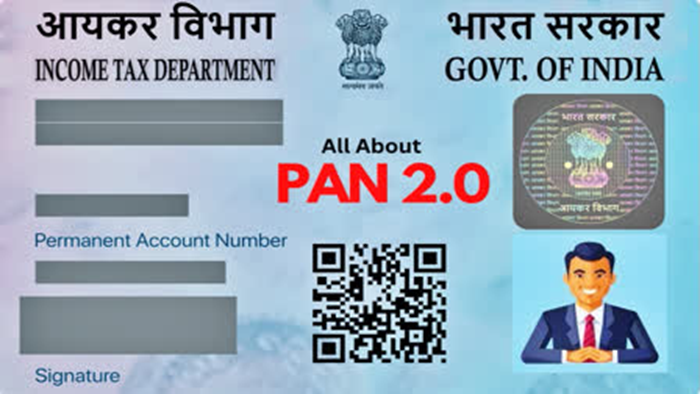- Courses
- GS Full Course 1 Year
- GS Full Course 2 Year
- GS Full Course 3 Year
- GS Full Course Till Selection
- MEP (Mains Enrichment Programme) Data, Facts
- Essay Target – 150+ Marks
- Online Program
- GS Recorded Course
- NCERT- First Ladder
- Polity
- Geography
- Economy
- Ancient, Medieval and Art & Culture AMAC
- Modern India, Post Independence & World History
- Environment
- Governance
- Science & Technology
- International Relations and Internal Security
- Disaster Management
- Ethics
- Current Affairs
- Indian Society and Social Issue
- CSAT
- 5 LAYERED ARJUNA Mentorship
- Public Administration Optional
- ABOUT US
- OUR TOPPERS
- TEST SERIES
- FREE STUDY MATERIAL
- VIDEOS
- CONTACT US
PAN 2.0: What is the Project and Why You Need to Upgrade Your PAN Card
PAN 2.0: What is the Project and Why You Need to Upgrade Your PAN Card
27-11-2024

- The Permanent Account Number (PAN), a 10-digit alphanumeric identifier issued by the Income Tax Department, is being upgraded to a more advanced system called PAN 2.0.
- The project includes several key changes, such as the addition of a QR code on all new and old PAN cards, a completely online application process, and a common business identifier to streamline various government systems.
- The upgrade aims to improve data security and simplify tax-related services.
- The Union Cabinet approved the PAN 2.0 project in November, 2024.
- Under this upgrade, PAN will become the single identifier for businesses and individuals, simplifying data management and ensuring better consistency of information across government systems.
1. What is PAN 2.0?
- Purpose: Modernization of the current PAN system to improve security and efficiency.
- Financial Investment: ₹1,435 crore for revamping the system.
- Unified Identifier: PAN will become a single identifier for both individuals and businesses, simplifying tax-related activities.
- System Integration: Merges PAN, TAN (Tax Deduction and Collection Account Number), and TIN (Taxpayer Identification Number) into a unified system.
2. Key Features of PAN 2.0
- QR Code: All PAN cards (new and existing) will feature a QR code for quick and easy access to PAN data, enhancing financial transaction connections.
- PAN Data Vault: A secure storage system for entities collecting PAN details (e.g., banks, insurance companies), aimed at improving data security and preventing misuse.
- Digital and Paperless: A fully online and paperless application process will replace the outdated system.
- Integration with Aadhaar: PAN will be connected with other identification systems, improving tax and identification efficiency.
3. Impact on Individuals and Businesses
- For Individuals:
- Free Upgrade: Existing cardholders can upgrade to PAN 2.0 with a QR code at no extra cost, through a paperless process.
- Improved Verification: The QR code enhances the speed and security of verifying PAN details for financial transactions and tax filing.
- For Businesses:
- Simplified Tax Filing: PAN becomes the sole identifier for all tax-related processes, including tax returns and payments.
- Unification of PAN, TAN, and TIN: Streamlines business tax activities and reduces administrative confusion.
4. Reasons to Upgrade Your PAN Card
- Improved Data Security: The data vault system ensures secure storage of PAN information, reducing identity theft risks.
- Seamless Integration: PAN 2.0 will integrate easily with multiple government services, making financial and tax management simpler.
- Faster Services: The online portal enables quicker PAN applications, updates, and issue resolution.
5. Existing Identification Numbers: PAN, TAN, TIN
- PAN: A unique 10-digit number linking individuals/businesses to their tax obligations, issued by the Income Tax Department.
- TAN: Issued to entities responsible for deducting or collecting tax at source (TDS/TCS).
- TIN: Issued to businesses for VAT-related activities, primarily for goods and services transactions.
6. Benefits of PAN 2.0 for the Economy
- Better Tax Compliance: The integration of PAN across government systems will improve tracking and management of tax compliance.
- Business Efficiency: Streamlined tax filing through unified PAN, TAN, and TIN reduces business administrative burdens.
- Enhanced Data Security: The introduction of the data vault system will protect personal and business information.
Conclusion
The PAN 2.0 Project aims to modernize the PAN system, making it more secure, efficient, and integrated with other government services. The upgrade is expected to make PAN the common identifier for individuals and businesses, streamlining tax filing, payments, and record-keeping. By upgrading your PAN card, you will benefit from better security, faster processing, and more efficient services, all at no cost.
Must Check: Best IAS Coaching In Delhi
UPSC Prelims Result 2024 Out: Expected Cut Off & Other Details, UPSC Prelims 2024 Answer with Explanation, Daily Prelims Quiz, Daily Current Affairs, MONTHLY CURRENT AFFAIRS TOTAL (CAT) MAGAZINE, Best IAS Coaching Institute in Karol Bagh, Best IAS Coaching Institute in Delhi, Daily Mains Question Answer Practice, ENSURE IAS UPSC Toppers, UPSC Toppers Marksheet, Previous Year Interview Questions, UPSC Syllabus
India’s EV Mission: Progress Delayed, Not Denied
India’s EV Mission: Progress Delayed, Not Denied



